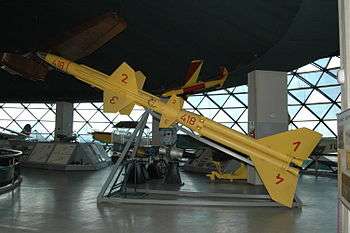R-25 Vulkan
The R-25 Vulkan (Serbian: Вулкан) was a surface-to-air missile (SAM) designed by Serbian engineer Obrad Vučurović and built in the Socialist Federal Republic of Yugoslavia (SFRY) in the late 1950s, early 1960s.
| R-25 Vulkan | |
|---|---|
 A telemetry-equipped R-25 on display at the Aviation Museum - Belgrade | |
| Type | Surface-to-air missile (SAM) |
| Place of origin | |
| Production history | |
| Designer | Obrad Vučurović at Military Technical Institute Belgrade |
| Designed | 1958 onwards |
| Manufacturer | SOKO |
| No. built | 12 |
| Specifications | |
| Mass | 1,413 kg (3,115 lb) at launch |
| Length | 8.10 m (26.6 ft) total length at launch |
| length | 5.24 m (17.2 ft) missile without booster rockets |
| Diameter | 350 mm (14 in) |
| Engine | RM-1000B sustainer 11.77 kN (2,650 lbf) thrust - sustainer, 245.25 kN (55,130 lbf) thrust - boosters |
| Propellant | liquid fuel sustainer, solid-fuelled boosters |
Operational range | 30 km (19 mi) |
| Flight altitude | 20 km (12 mi) |
| Maximum speed | M2.5 |
Guidance system | Radar initially with infra-red terminal guidance |
Steering system | Aerodynamic |
Development
The mid-1950s saw the emergence of viable SAMs for the purpose of air defence. Due to their inability to import foreign SAM systems, in 1958 Yugoslavia initiated a program to develop an indigenous missile at the Belgrade Military Technical Institute.[1] Designated the R-25 Vulkan (Volcano), this completely original Yugoslavian design brought together a team of experts led by engineer Obrad Vučurović to design the missile, with the prototypes being made in the SOKO aircraft factory in Mostar.[1]
Two versions of the missile were developed: one that had a booster-rocket engine with seven rockets and a second one with four rockets. Although, initial prototypes used a liquid fuel rocket engine developed for a rocket-powered torpedo, later operational production missiles would use a solid-fueled engine with twice the thrust.[1] The development of the launcher and radar system was inspired by the Japanese Kappa meteorological sounding rocket imported into Yugoslavia.[2] The target detection and information collection system was supplied by Yugoslav-made OAR M-61 “Fruška Gora” S-Band surveillance and acquisition radar, and in-course guidance was supplied by a British No. 3 Mk. 7 aiming radar.[1] For operational use, there existed the possibility of using more sophisticated radar equipment,[1] and for terminal guidance the missile would switch to independent homing by infrared sensors in its nose cone.[1] The advanced guidance system of the R-25 was automatic after launch with no further operator input needed.[1]
Use
The first launch of the missile was conducted in November 1962, revealing problems with the liquid-fueled sustainer rocket motor.[1] Concurrently, with the R-25 testing in 1962 the SFRY acquired S-75 Dvina (Russian: С-75; NATO reporting name: SA-2 Guideline), missile systems from the Soviet Union.[1] As such, by the end of 1964 the decision was made to abandon the Vukan project that produced a total of twelve missiles.[1] The knowledge and experience gained during this project were later incorporated into other projects for production of other armaments for the Yugoslav People's Army (JNA).[1]
Survivors
A single R-25 Vulkan missile is preserved at the Museum of Aviation Museum in Belgrade; intended for in-flight testing, the warhead has been replaced by measuring and telemetry equipment.[1]
External links
References
- "Соко Вулкан (ракета З-В)". Belgrade Museum of Aviation. Archived from the original on May 5, 2014. Retrieved January 18, 2013.
- Ichiro Matsuo (July 16, 2012). "Japan rocket technologies misused by Yugo military in 1960s". Asahi Shimbun. Archived from the original on October 21, 2012. Retrieved January 18, 2013.